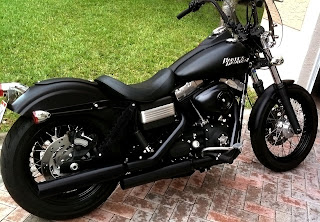




" Most people probably know the biker's as the actors who played them in the film. These are the guys whose faces you see whenever there is a close up, and the names you see in the credits. They fit the part well and are all very believable in their roles, and many of them even do some riding in the film. Sometimes the actors even got to perform a bit of the mindless destruction...
However, you don't really want to have your actors actually riding the bikes in packs, chasing cars, and doing anything too dangerous...
So, for the bigger riding sequences, and especially for the stunts, the actors were replaced by a mixture of stuntmen, and bikers from local Melbourne clubs. The primary club used for most of the film was The Vigilantes.
Riders from the Vigilantes performed a lot of the precision stunt work, such as burnouts, donuts, monos, and even a few falls. The donut and mono by the Toecutter's gang in Clunes was a Vigilantes rider, as was Goose's burnout down Claremont Street. Even the infamous bike to the back of the head stunt was a Vigilantes rider (although, clearly, the bike hitting the rider wasn't actually intended - luckily the rider walked away unharmed). It was only when it came down to the most dangerous stunts that the professional stuntmen stepped in. For example, the scene where the two bikers go off the side of Kirk's Bridge, which was performed by stuntmen Grant Page and Chris Anderson.
The other main club involved in the making of Mad Max was the Victorian Four Owners Club. When you see Toecutter's gang padded out with a very large number of bikers, such as the scenes in Clunes, the Victorian Four Owners Club are the ones making up the numbers.
Of course, one final person who deserves an honorary bikers credit would have to be David Eggby. For anyone who ever wanted to know how Goose's wild ride was filmed, the photo below is your answer. David Eggby simly strapped himself to the back of the bike, 35mm camera in hand, and just went for it! So next time you watch the film, check out the speedo cranking over in those shots, and remember that just like many of the chase sequence shots in Mad Max, it's all for real."
Took this from a site called: madmaxmovies.com













































